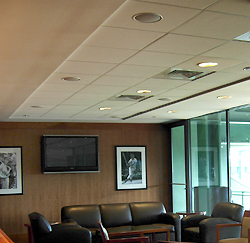
EQ Strategies
It is often best to adopt the strategy of only cutting the EQ filters, never boosting them.
Peaks in the frequency response can be more bothersome and can be equalized out.
Dips in the frequency response tend not to be as audible and because they are frequently caused by time-related phenomena, they are often not equalizable.
So it’s usually best not to bother with equalizing out the dips in the frequency response curve.
A graphic EQ with only a few bands is probably not of much use in EQing a system. In order to remove the peaks, you end up taking out way too much good sound content.
Note that as with graphic EQs, you must be wary of large boosts and cuts in adjacent filter bands. Use equalization gently.
More and more DSP-based business music controllers now include parametric EQs, which are often more useful than graphic EQs because you can really pinpoint the frequency required and narrow the filter enough to take out only as much as needed without taking out too much content.
Do not try to equalize reflections—even those that show a peak at your measurement position—because they change with every mic position in the room. If you’re not sure what’s real, move the mic to a number of locations and see what peaks are common to all locations.
I like to set the EQ for a gentle roll-off of high frequencies. A roll-off of somewhere around 3 dB, starting at 2 kHz per octave (4 kHz being down 3 dB) often sounds better than setting it flat.
For bass frequencies, you may have to experiment with what sounds best for that application. You might need to set the bass frequencies (below 90 Hz) up as much as 10 dB higher than the mids and highs in order to balance the sound.
Be careful not to boost bass frequencies that the loudspeaker can’t handle. Ported loudspeakers can’t handle their full rate power below their tuning frequency, so find out from the manufacturer what frequency the loudspeaker is tuned at, and make sure not to send it frequencies lower than what it was built to handle.
One factor affecting how much higher to set the bass (compared to the mids) is how loud the system will be played. Unfortunately, music itself goes up and down in level, so the balance is going to be wrong at some music levels.
Unless you’ve got a dynamic system that automatically adjusts for this (such as the Autowarmth function on JBL’s SoundZone controllers and some dbx zone controllers), you’re probably going to need to just split the difference and set the bass volume somewhere between the loudest and the softest musical volumes.
In Review
Now you know some key steps in putting together a top-quality business music system. So, let me summarize a few key points:
• Lay out the system based on the real coverage as projected onto the listening plane — don’t base it on the polar coverage specification from the spec sheet.
• Help customers avoid the assumption that a loud sound system is necessarily a good sound system. Design a system that has the real SPL capability that’s going to be required, without distorting or becoming harsh.
• Don’t assume that the computed pink noise capability of a system is what they’re going to be able to get with music or speech.
• Guard against the common computational mistake of assuming that you’ll get the SPL you computed at 70 volts from a 70-volt system.
• After the installation, be sure to EQ the system with the right microphone setup, avoiding some of the common EQ mistakes mentioned above.
Next time I’ll focus on loudspeaker layout and other issues.
Rick Kamlet is senior manager, commercial sound, JBL Professional. Published with permission by JBL.
